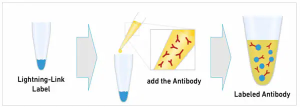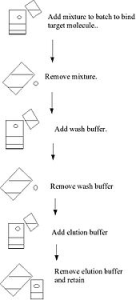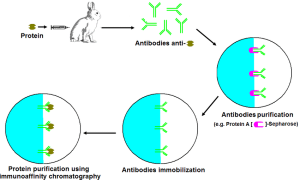Introduction:
- Antibody conjugation, also known as antibody labelling, is a technique for modification of antibodies which involves with the attachment of a specific tag to an antibody.
- Antibody conjugation, also known as antibody labelling, is the process of chemically linking an antibody to a specific tag
- These labelled antibodies can be used to isolate and purify a protein of interest from a complex mixture, usually cells, tissues or whole organisms.
Horseradish peroxidase (HRP) is a common enzyme for antibody conjugation. HRP has only six lysines, and modifying them has little effect on the enzyme’s activity.

Source: https://doi.org/10.4155/bio.10.31
Common Antibody Conjugation Methods:
Antibodies, like all proteins, are made up of amino acids. Bioconjugation is theoretically feasible with most amino acids. For lysine-based antibody conjugation, a variety of approaches are available, as discussed below.
NHS (Succinimidyl) ester method
This approach can be used to conjugate antibodies with commonly accessible fluorescent dyes like rhodamine derivatives.
Isothiocyanate method
This approach can be used to create fluorescein isothiocyanate (FITC), which is commonly used to generate fluorescent proteins and antibodies.
Periodate method
This technique can be used to make customized HRP-antibody conjugates. HRP is activated by periodate, which produces aldehyde molecules that connect with lysine residues.
- Antibody labelling, or the attachment of a specific tag to an antibody to aid in detection or isolation/purification of a protein, is an important technique.
- Labelled antibodies are essential for immuno-based assays such as Western blots, ELISAs, flow cytometry, immunohistochemistry (IHC) and immunofluorescence (IF).
- Labelled antibodies are also used to isolate and purify a single protein from a complex mixture of proteins. Antibodies, like other proteins, can be labelled with small molecules, radioisotopes, enzymatic proteins and fluorescent dyes.

Source: Google
What are the key considerations for antibody conjugation?
These aspects should be considered in producing a high-quality conjugation:
Purification:
For conjugation, only purified antibodies are appropriate (i.e., not crude serum or tissue culture supernatant).
Buffer:
Certain buffer constituents are incompatible with the labelling reaction
Concentration:
The antibody concentration should be at least 1 mg/mL.
How to select antibodies?
Antibodies as a research tool. Antibodies for antigens have a high specificity, which has allowed researchers to obtain access to a wide range of information.
1) Detection of target molecules
The expression levels and localisation of molecules of interest are determined using antibodies.
Application: Western blotting, immunoprecipitation, ELISA, flow cytometry, immunohistochemistry, etc.
2) Isolation and purification of target molecules
Only the target molecules are extracted from extensive mixtures containing many proteins, nucleic acids, amino acids, hormones, and other compounds, such as cell and tissue extracts.
Example: Antibody-coated agarose is used to purify epitope-tagged proteins.

Fig: Antibody-Drug Conjugate Manufacturing Process
3) Isolation and purification of cells
Antibodies to the target protein are used to separate cells expressing a cell surface target protein from a mixture of cells.
4) In vivo functional study of a target molecule
Functions of target molecules are analysed in vivo by administering inhibitory (or stimulatory) antibodies to cultured cells and experimental animals.
Example: Anti-tumour effect of the antibody to the Treg marker GITR (DTA-1) was evaluated in tumour-bearing mice.
Immunoaffinity chromatography: Separation of antigens and antibodies
Affinity chromatography is a useful approach for separating antibodies, antigens, and proteins based on the interaction of certain immobilized ligands with the target antibody, antigen, or protein.
The target molecule is reversibly adsorbed by a ligand deposited onto an insoluble substrate in affinity chromatography, a highly selective separation process.
The ligand is chosen based on its affinity for a biomolecule, such as an antibody’s affinity for its antigen or an antigen’s affinity for its antibody.
The binding affinity of an antigen to a parent antibody is utilized as a basis for separation in immunoaffinity chromatography (IAC). Antigens and antibodies have strong and specific interactions, allowing them to be used in IAC with either immobilized antigens or antibodies.


Source: https://doi.org/10.4155/bio.10.31
References:
- Hsieh-Chih Tsai, Toyoko Imae, in Progress in Molecular Biology and Translational Science, 2011
- Amitava Dasgupta PhD, in Biotin and Other Interferences in Immunoassays, 2019
- Criscitiello, C., Morganti, S. & Curigliano, G. Antibody–drug conjugates in solid tumors: a look into novel targets. J Hematol Oncol 14, 20 (2021). https://doi.org/10.1186/s13045-021-01035-z
